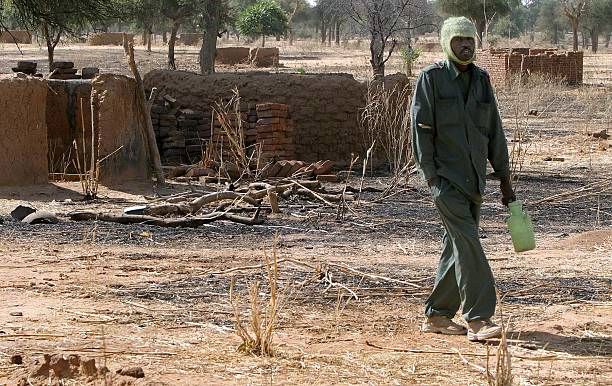Koert Lindijer has been a correspondent in Africa for the Dutch newspaper NRC since 1983. He is the author of four books on African affairs.
The violence in Darfur is deja vu. In June 2004 I travelled in Darfur during the war and wrote this feature on the destruction of Kailek. At that time the terror came from the Janjaweed, which is now called the Rapid Support Forces(RSF). The violence then resembles the actrocities taking place now, allthough Darfuri complain this time it is even worse.
“Something horrible happened in Kailek,” whispers a trader in the village of Bromga in Sudan’s Darfur region. He glances nervously at his fellow Arabs. When he tries to talk more about neighboring Kailek, a man with a Kalashnikov pushes him away and snaps: “He’s a liar.” He points to burned-out houses in Bromga: “The African rebels attacked us Arabs here in our village; don’t believe what he tells you.”
Burned-down villages lie to the left and right of the sandy path to Kailek. Men pass by, on horses, camels, and donkeys, armed with guns, knives, and swords. Some are in civilian clothes, others wear government army or police uniforms. They wave politely. They are the feared Janjaweed, the Arab militias formed by the Sudanese government in Darfur to suppress a rebellion by African resistance movements. They have done so with brutal force: nearly two million people have been displaced; no one knows how many have been killed, but rough estimates put the number at least in the tens of thousands.
Kailek is a green oasis in the sandy landscape. Horror looms beneath the palm trees. The town is charred and depopulated. A lone dog limps away, a lame donkey brays. Where the market once stood, ibises peck from smashed pots and pans. The thatched roofs of the mud houses have been burned. Everything is destroyed: the mosques, the food warehouses, a garage, the shops. Everything. Around the collapsed police station, under the mango trees, all the grass has been trampled, as if a crowd had once stood there. A little further on, there are a few freshly made graves. Among a pile of torn women’s clothes lie bullet casings.
The answer to the question of what disaster befell Kailek lies in the district capital, Kas, 60 kilometers to the east. Kas has 35,000 inhabitants, joined by 45,000 displaced people from the surrounding area, many from Kailek and the surrounding area. They have settled in school buildings, around the water towers, near the market—everywhere. The displaced people are Muslim, like the Arab and Arabized Sudanese in Darfur, but of African descent. And they are farmers, unlike their Arab compatriots, who live nomadically from their livestock.
The secrecy of the Arabs in the village of Bromga, the suspicion about what happened in Kailek is absent here. “Sir, I’m too old to lie,” begins elderly Adam Mussa from Kailek. With two religious leaders at his side and surrounded by a large group of displaced people, he tells the story of Kailek.
One day in early February, at four o’clock in the afternoon, the attack on the town of several thousand inhabitants was launched. “The Janjaweed militia fighters on their horses came first and surrounded Kailek. Then came the government soldiers in twelve cars. They killed our children, the blind, the disabled; only the stronger among us could run away to the hills. Our houses were set on fire.” Bystanders began to shout how many family members they had lost. No family seems spared. Hundreds must have been killed.
This was only the beginning of Kailek’s torture. Two days later, the government soldiers left, leaving the Janjaweed fighters behind. After a week, most of the displaced residents had returned from the hills. They were hungry and believed the Janjaweed’s promise of safety. However, they were no longer allowed to leave the town.

Women raped for days
“All male residents were ordered to gather around the police station,” a spiritual leader from Kailek explains. “Some Arab residents of our town had joined the Janjaweed. They called out the names of villagers, every day. Those who had to report were taken to the riverbed and executed.”
A heavy man pushes forward, showing a large scar on his neck. The Janjaweed fighters tried to hang him, but the rope broke, and he pretended to be dead. Women look down in shame. They were separated from the men and raped for days. After some prodding, a 15-year-old girl recounts how she was tied up by Janjaweed fighters, who raped her for ten days.
For two months, the Janjaweed fighters occupied Kailek. Only villagers who could pay ransoms were allowed to leave. According to the villagers, the Janjaweed leader was Ahmed Abu Khamasha. He worked closely with Ahmed Ngabu, the highest district administrator in the region around Kas. This district administrator visited Kailek several times during the occupation. Only after the intervention of the head of a foreign aid organization, who happened to be in the area—foreign aid workers and journalists are allowed into Darfur only with very limited permission—did he order the Janjaweed to leave the town. This foreign aid worker confirms the residents’ account. By the end of April, all the survivors of Kailek and surrounding villages had arrived in Kas.
“The rapes, the murders, the torture—all these horrors are engraved on our hearts,” the elderly Adam Musa concludes his story. “How can we ever return to Kailek with these memories? And how can we ever trust the government again? They armed the Janjaweed, they gave the green light for the destruction of Kailek because we would support the rebels. Let me tell you, sir, we never saw a single rebel in our village.”
A journey through this vast region reveals thousands of charred villages and towns, almost exclusively inhabited by Sudanese of African descent. The displaced in Darfur are still not safe. Janjaweed fighters patrol the streets of Kas at night. Some displaced people have been arrested and never seen again. Women who went to fetch water or collect wood were raped. And in Kas, as in almost all of Darfur, there are no foreign aid workers to ensure their safety.
Only in Bromga does it seem safe, and the Arabs are doing a good business there. Adam Musa jumps up at the mention of that name Bromga. “That’s not their village at all, that’s our village,” he shouts angrily. “The Janjaweed fighters attacked Bromga, burned many houses, and drove out the Africans. Then they gave it to the Arabs.”
This article was first published in NRC Handelsblad on 3-6-2004

